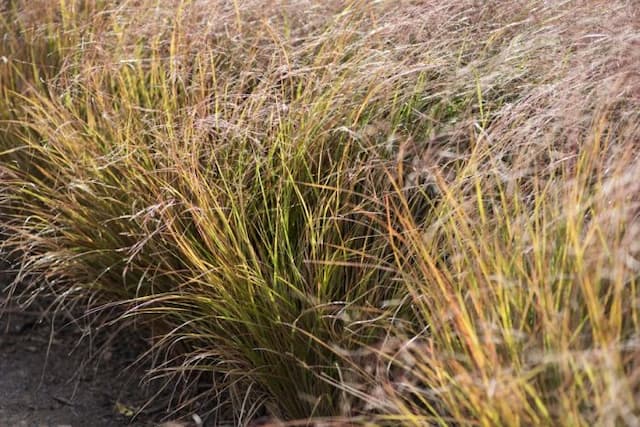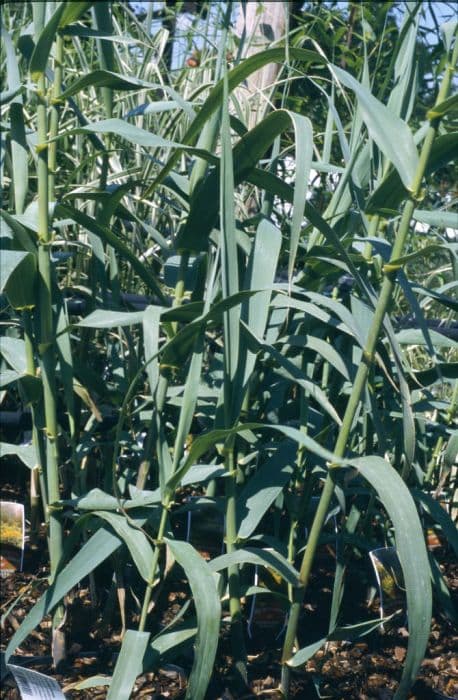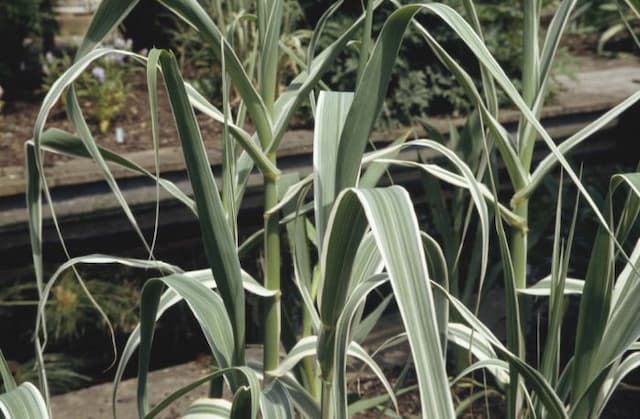Fountain Bamboo Fargesia nitida 'Nymphenburg'

ABOUT
Fargesia nitida 'Nymphenburg', commonly known as the fountain bamboo, presents a graceful and arching habit, contributing to its descriptive name. This clumping bamboo is known for its lush and dense growth. The foliage is narrow and lance-shaped, displaying a rich green hue, which can bring a vibrant and exotic touch to any garden space. The canes, also referred to as culms, are another striking feature of the fountain bamboo. When young, they exhibit a purplish or blue-tinged color, which gradually matures to a more subdued gray or green shade. The color transition of the culms adds a dynamic visual interest throughout the seasons. The leaves of the fountain bamboo are not overly large but are numerous, contributing to the dense and bushy appearance of the plant. During the cooler months, the foliage may develop a slightly lighter or yellow-green tone before returning to its deep green color in the spring. The overall form of the fountain bamboo, with its arching stems and thick growth of foliage, can create a sense of movement, as if the plant were a green fountain frozen in time. This effect makes it an attractive choice for creating a privacy screen or as a solo specimen in a serene, Asian-inspired garden setting. The fountain bamboo is appreciated for its hardiness and ability to withstand cold temperatures, which further adds to its appeal for gardeners in a variety of climates.
About this plant
 Names
NamesFamily
Poaceae.
Synonyms
Fountain Bamboo, Chinese Fountain Bamboo.
Common names
Sinarundinaria nitida, Arundinaria nitida, Fargesia spathacea.
 Toxicity
ToxicityTo humans
There is no widely reported toxicity of Fargesia nitida, commonly known as Fountain Bamboo, to humans. This means that, in general, it is not considered poisonous, and there should not be any significant symptoms of poisoning from ingesting parts of this plant. However, as with any plant material, individual allergies or sensitivities could cause mild stomach discomfort or other allergic reactions in some people.
To pets
Fountain Bamboo is also not commonly known to be toxic to pets. This means that it is generally considered safe for animals like dogs and cats, and there should not be significant toxic effects if pets ingest parts of this plant. As with humans, individual animals might have sensitivities, and ingestion might lead to mild gastrointestinal upset or other allergic reactions in some pets.
 Characteristics
CharacteristicsLife cycle
Perennials
Foliage type
Evergreen
Color of leaves
Green
Height
8 feet (2.4 meters)
Spread
4 feet (1.2 meters)
Plant type
Shrub
Hardiness zones
5
Native area
China
Benefits
 General Benefits
General Benefits- Ornamental Value: Fargesia nitida 'Nymphenburg', commonly called the Fountain Bamboo, adds aesthetic appeal to gardens with its graceful fountain-like growth habit and attractive green foliage.
- Precision in Growth: Unlike some bamboo varieties, this clumping bamboo does not spread aggressively, making it a good choice for gardens where space and containment are concerns.
- Hardiness: Fountain Bamboo is known for its cold tolerance, being able to withstand temperatures down to about -20 degrees Celsius, making it suitable for a wide range of climates.
- Privacy Screen: Due to its dense growth, Fountain Bamboo is an excellent natural screen, providing privacy and reducing noise when planted in rows or hedges.
- Shade Tolerance: This bamboo species can grow in a range of light conditions, including partial shade, providing flexibility in garden design.
- Low Maintenance: Once established, Fountain Bamboo requires relatively low maintenance, with minimal pruning and care needed.
- Erosion Control: The root system of clumping bamboos can help to stabilize soil and prevent erosion on slopes or banks.
- Wildlife Habitat: The dense foliage can provide shelter and nesting opportunities for birds and other wildlife.
- Drought Resistance: Once established, it can be quite drought tolerant, although it prefers a consistently moist soil.
- Container Gardening: Fountain Bamboo can be grown in containers, which makes it a versatile choice for patios, balconies, and small spaces.
 Medical Properties
Medical PropertiesThis plant is not used for medical purposes.
 Air-purifying Qualities
Air-purifying QualitiesThis plant is not specifically known for air purifying qualities.
 Other Uses
Other Uses- As a privacy screen: Fargesia nitida 'Nymphenburg', also known as Fountain Bamboo, can be used to create a dense and attractive natural screen, providing privacy for gardens and outdoor spaces.
- Fountain pen production: The hard culms of the Fountain Bamboo can be fashioned into the wooden bodies of fountain pens, providing an organic, aesthetic appeal to writing instruments.
- Sound insulation: Planting a row of Fountain Bamboo along a property line can help to reduce noise pollution due to its dense foliage and thick growth habit.
- Soil erosion control: The root system of Fountain Bamboo helps stabilize soil on slopes and riverbanks, preventing erosion and providing support to the surrounding terrain.
- Windbreaks for crops: Fountain Bamboo can be planted in agricultural areas to act as windbreaks, protecting smaller, more sensitive crops from strong winds.
- Live fencing: Due to its dense growth, Fountain Bamboo can be cultivated as a living fence around properties, offering a sustainable and eco-friendly alternative to manufactured fencing materials.
- Ornamental water features: Stems of Fountain Bamboo can be incorporated into water features or ponds to add a natural and exotic touch to garden landscaping.
- Shade provider for outdoor seating areas: Strategically planted Fountain Bamboo can offer natural shade for patios, decks, or garden seating spots, enhancing outdoor comfort during sunny days.
- Culinary presentation: Thin strips or sections of Fountain Bamboo stems can be used as an attractive, natural plating option for serving sushi or other Asian-inspired dishes.
- Artistic medium: Dried Fountain Bamboo stems can be used by artists and crafters in the creation of naturalistic sculptures or as structural elements in mixed-media artworks.
Interesting Facts
 Feng Shui
Feng ShuiThe Fountain Bamboo is not used in Feng Shui practice.
 Zodiac Sign Compitability
Zodiac Sign CompitabilityThe Fountain Bamboo is not used in astrology practice.
 Plant Symbolism
Plant Symbolism- Resilience: As a species of bamboo, Fargesia nitida 'Nymphenburg', commonly known as Fountain Bamboo, symbolizes resilience due to its ability to bend without breaking and quickly recover from harsh conditions.
- Flexibility: The flexibility of Fountain Bamboo's canes represents adaptability and the willingness to go with the flow of life's complex situations.
- Growth and Vitality: Fountain Bamboo, like other bamboo species, grows quickly and vigorously, symbolizing rapid growth and strong life force.
- Privacy and Protection: Fountain Bamboo is often used in gardens to create natural screens, symbolizing privacy, protection, and the idea of shielding from outside troubles.
- Peace and Serenity: With its lush foliage and graceful form, Fountain Bamboo is believed to contribute to a serene and peaceful environment, symbolizing tranquility and calm in one's surroundings.
 Water
WaterThe Fountain Bamboo should be watered deeply once a week during the growing season but may require more frequent watering during periods of extreme heat or drought. It's important to allow the top inch of soil to dry out slightly before watering again. Each watering session should provide enough water to moisten the soil to a depth of several inches; for a mature plant, this could mean using up to 2 gallons of water each time. During winter, reduce watering to every other week or less, depending on the climate and whether the plant is receiving rainfall.
 Light
LightFountain Bamboo prefers a location with bright, indirect light or dappled sunlight. It can tolerate some direct morning sunlight but should be protected from the intense afternoon sun to avoid leaf scorch. Ideally, planting it in a spot that receives shade during the hottest part of the day will ensure the best growth and leaf coloration.
 Temperature
TemperatureFountain Bamboo thrives in temperatures ranging from 55°F to 75°F and can tolerate conditions down to around -10°F once established. The ideal temperature range provides a comfortable environment for growth without the risk of heat stress or frost damage. Sudden drops below this range should be avoided to prevent damage to the plant.
 Pruning
PruningPruning Fountain Bamboo is mainly needed to maintain its shape and remove any dead or damaged canes. Pruning should be done in the late winter or early spring before new growth starts. Thin out older canes to encourage new shoots, and cut them at ground level. Annually removing about a quarter of the oldest culms will keep the plant looking fresh and healthy.
 Cleaning
CleaningAs needed
 Soil
SoilBlue Fountain Bamboo prefers a well-draining, loamy soil with a high organic content. The soil mix should comprise two parts loam, one part peat or leaf mold, and one part sharp sand or perlite to aid drainage. This bamboo thrives in a soil pH ranging from slightly acidic to neutral, around pH 5.5 to 7.
 Repotting
RepottingBlue Fountain Bamboo should be repotted every 2-3 years to prevent root-bound conditions and refresh the soil. Choose a pot that is slightly larger than the current one, as this bamboo does not require overly spacious containers.
 Humidity & Misting
Humidity & MistingBlue Fountain Bamboo does best in moderate to high humidity levels but is quite adaptable. Aim for a humidity level of around 40-60% for optimal growth.
 Suitable locations
Suitable locationsIndoor
Place Blue Fountain Bamboo in bright, indirect light, away from drafts.
Outdoor
Plant in partial shade, protect from strong winds and intense afternoon sun.
Hardiness zone
5-9 USDA
 Life cycle
Life cycleFargesia nitida 'Nymphenburg', also known as the 'Nymphenburg' clumping bamboo, initiates its life as a seed, although it is more commonly propagated vegetatively through division. After germination or planting of divisions, the plant enters a juvenile phase, where it starts to produce small, narrow leaves and delicate, immature culms (bamboo stems). As the plant matures, it undergoes a rapid growth phase where the culms thicken, elongate, and the plant produces dense foliage, which can occur within a few weeks under optimal conditions. The bamboo then enters a period of vegetative stability where it focuses on strengthening and expanding its rhizome network, contributing to its clump-forming growth habit. After several years, which can vary significantly depending on environmental conditions, Fargesia nitida 'Nymphenburg' reaches sexual maturity and may produce flowers, an event that is infrequent and can proceed into a mass flowering followed by die-off of the flowering culms. Following flowering, if viable seeds are produced and dispersed, they may germinate and the lifecycle begins anew, while the parent plant rejuvenates from surviving rhizomes.
 Propogation
PropogationPropogation time
Spring to early summer
Fargesia nitida 'Nymphenburg', commonly known as Fountain Bamboo, is typically propagated through division, which is the most popular method for this species. The best time to propagate it by division is in the spring as the plant comes out of dormancy and the chances of stress are minimized. To propagate Fountain Bamboo by division, a healthy, mature clump is selected and carefully excavated from the ground. Using a sharp spade, the root mass is then cut into smaller sections, each with several growing culms and a healthy root system. The divisions are immediately replanted at the same depth they were growing at previously and watered thoroughly. It's crucial to keep the new plantings well-watered, especially in the first growing season, to ensure a strong establishment.









